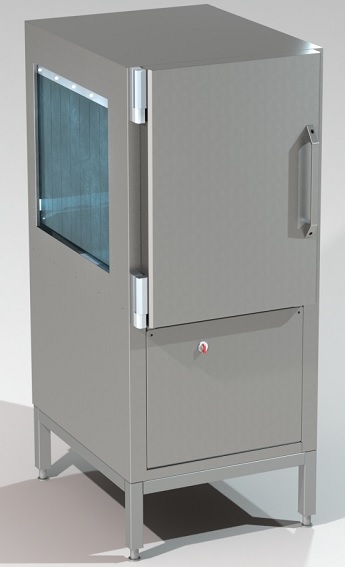Cleaning
Stainless steel equipment and fixtures must be cleaned on a regular basis to prevent them from rusting. A water wash is often sufficient for cleaning a stainless steel surface; hot water and steam can be used in special cases. Impurities and deposits that have adhered to the stainless steel surface can be removed by rubbing them with an emery cloth, for example.
The emery cloth must be non-ferrous. It is advisable to first try the treatment on a less noticeable part of the product.
A sink with rounded edges, removable washing arms, overflow protection pipe, pump screen, rubber curtains and strainer baskets are all easy to keep clean. The washing arms can be removed by simply releasing the latch locking mechanism. The aforementioned parts must be washed on a regular basis.
The pipe of the magnetic float must be cleaned and checked for fouling on a regular basis to ensure sufficient water supply to the pump. Washing with a brush from the outside and from the inside where accessible, for example, is sufficient.
The machine is designed to have enough room under it so as to be readily accessible with cleaning equipment so that it is easy to keep clean.
If the machine is to be out of service for a prolonged period of time, it must be washed thoroughly.
Detergents
Standard cleaning powders or power detergents such as soda, borax or sodium perborate can be used for cleaning stainless steel surfaces.
Alkaline solutions, such as soda, ammonia and diluted soda lye, can be used for dissolving grease. Acetone, petrol, alcohol and similar organic solvents can also be used for removing grease deposits or other water-insoluble matter.
Detergents that contain sulphuric or hydrochloric acid may not be used for cleaning stainless steel surfaces.
Disinfection
The most affordable disinfectant that is suitable for stainless steel is nitric acid; even mild concentration solutions have a bactericidal effect.
The sterilising agents used for disinfection often contain sodium hypochlorite or potassium hypochlorite. However, these substances are dangerous to stainless steel as they easily give rise to pitting corrosion. Other disinfectants that contain chlorine, such as chloramines, are also dangerous.
Servicing and repair
To avoid potential failures and malfunctions, the prewash machine should only be repaired by a qualified professional.
We service and provide spare parts for all equipment and fixtures we have made. In servicing matters, we kindly ask you to contact our sales service, who will assist and serve you on weekdays from 8am to 4pm.
Our salespersons will advise you on matters related to servicing, and you can book a suitable servicing appointment with them where necessary. We will make every effort to book the first available servicing appointment with due consideration given to the availability of spare parts, the urgency of the matter and the customer’s wishes.
In servicing matters we kindly ask you to check in advance the details of the fixture and equipment concerned so that we will be able to determine its history and components.
Our repairmen, based in our factory located at Tempo 4, Järvenpää, Finland, operate throughout Finland.
We do not recommend making any changes to the product.
Carrying out any repairs on electrical components is strictly forbidden – contact the manufacturer.
Any damaged components must be replaced – contact the manufacturer.
We provide spare parts for all products we manufacture – contact the manufacturer.
